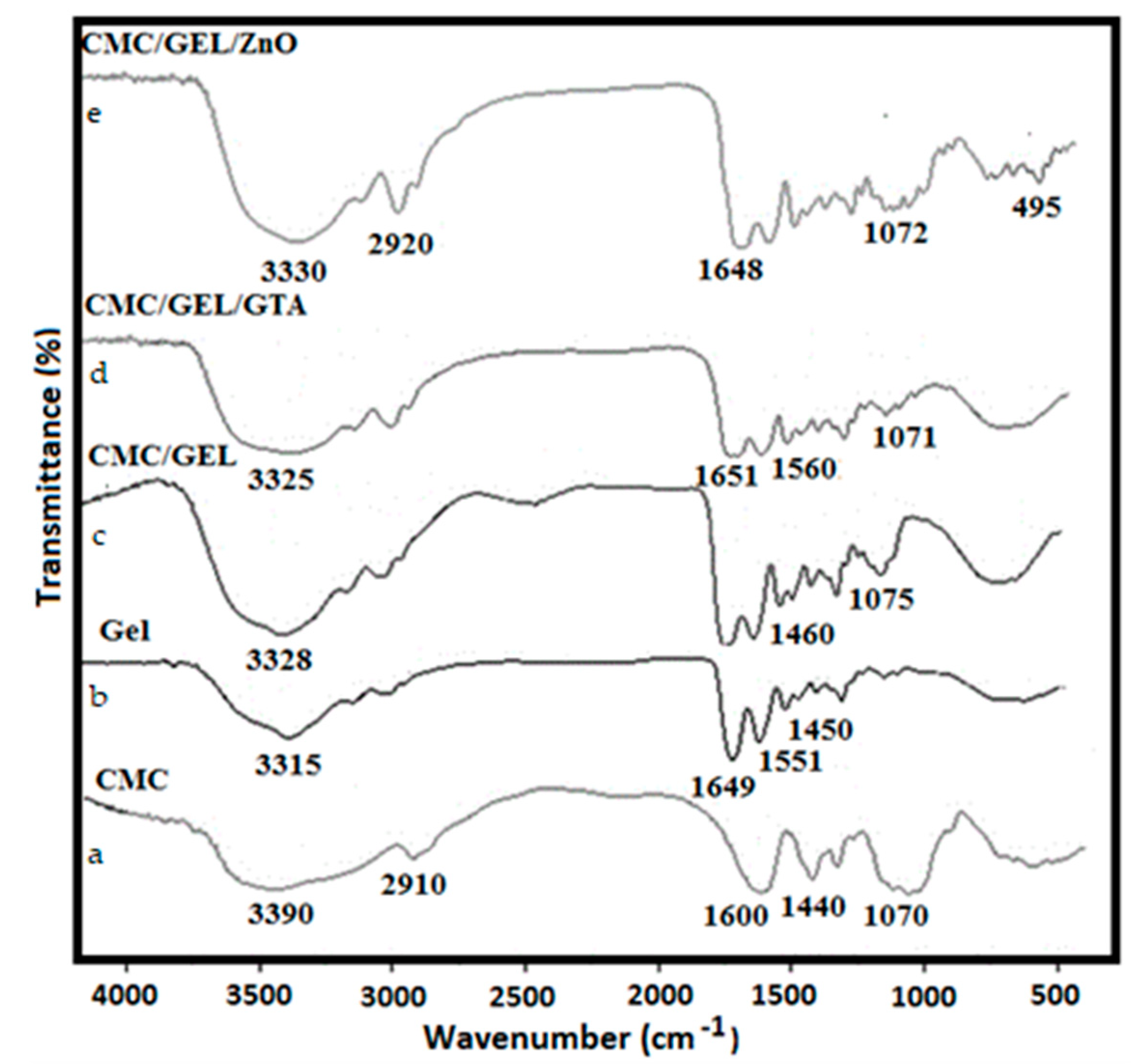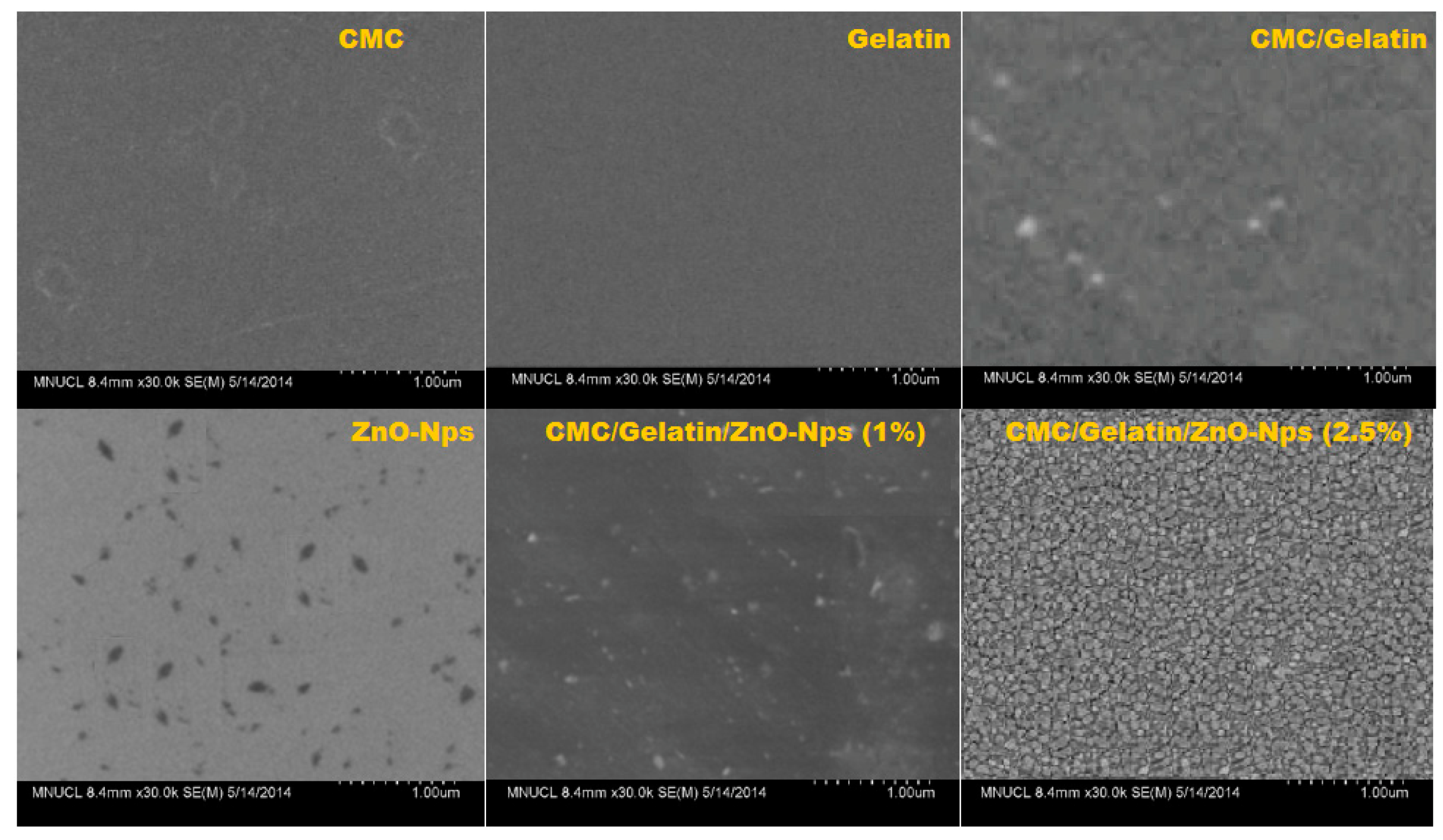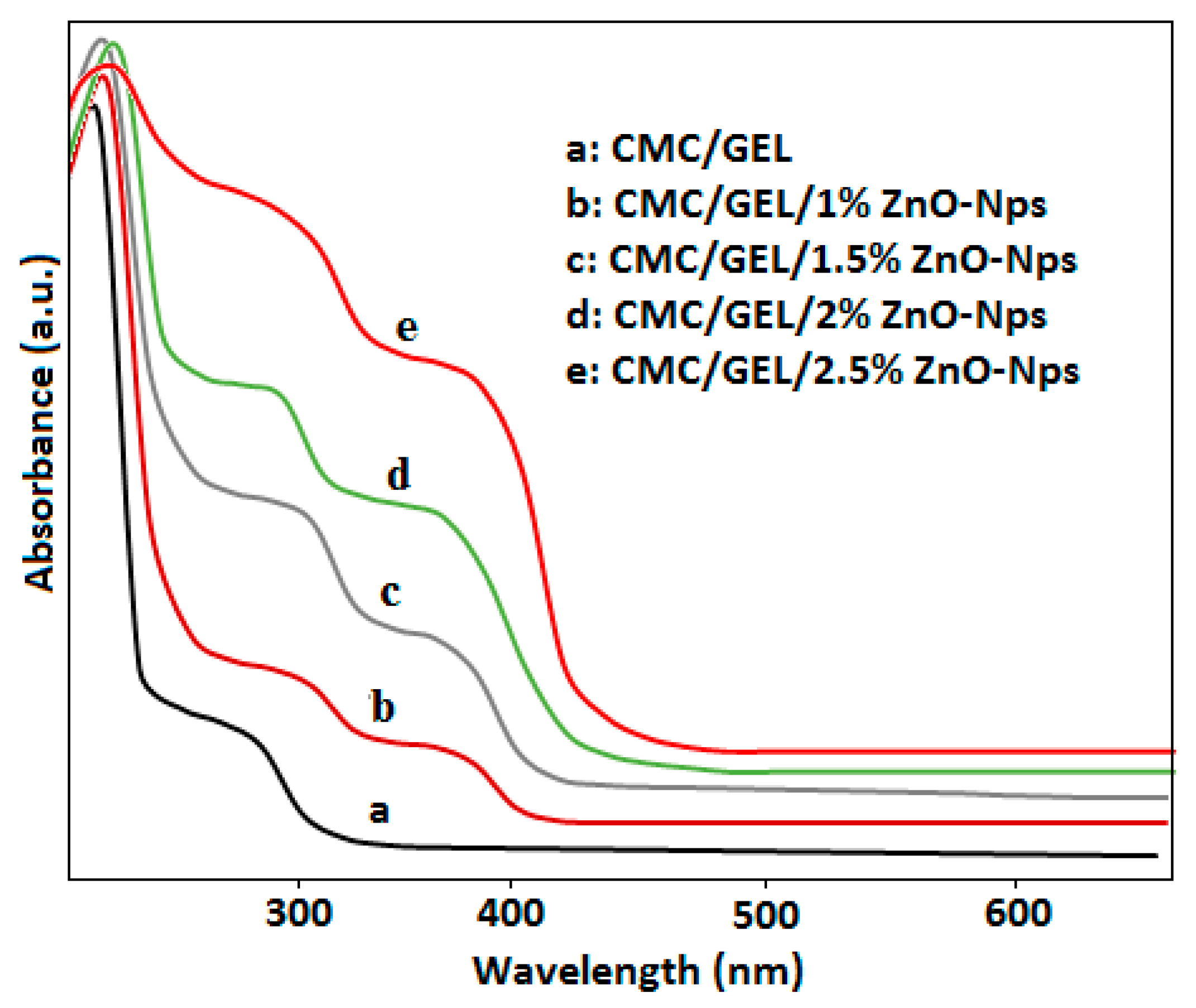Carboxymethyl Cellulose/Gelatin Hydrogel Films Loaded with Zinc Oxide Nanoparticles for Sustainable Food Packaging Applications
Abstract
1. Introduction
2. Materials and Methods
2.1. Chemicals
2.2. Chemical Characterization
2.3. Green Synthesis of ZnO-Nps
2.4. Fabrication of Carboxymethyl Cellulose-Gelatin-ZnO Composite Films
2.5. Moisture Contents and Water Vapor Permeability
2.6. Antimicrobial Assay
2.7. Antioxidant Assays
3. Statistical Analysis
4. Results and Discussion
4.1. IR Investigation
4.2. XRD Analysis
4.3. Morphological Studies
4.4. Optical Properties
4.5. Thermal Stability
4.6. Mechanical Properties
4.7. Moisture Content and Water Vapor Permeability
4.8. Antibacterial Results
4.9. Antioxidant Activity
5. Conclusions
Author Contributions
Funding
Institutional Review Board Statement
Informed Consent Statement
Data Availability Statement
Acknowledgments
Conflicts of Interest
References
- Sohail, M.; Sun, D.W.; Zhu, Z. Recent developments in intelligent packaging for enhancing food quality and safety. Crit. Rev. Food Sci. Nutr. 2018, 58, 2650–2662. [Google Scholar] [CrossRef]
- Atta, O.M.; Manan, S.; Ahmed, A.A.Q.; Awad, M.F.; Ul-Islam, M.; Subhan, F.; Ullah, M.W.; Yang, G. Development and characterization of plant oil-incorporated carboxymethyl cellulose/bacterial cellulose/glycerol-based antimicrobial edible films for food packaging applications. Adv. Compos. Mater. 2022, 5, 973–990. [Google Scholar] [CrossRef]
- Pernas-Pleite, C.; Conejo-Martínez, A.M.; Marín, I.; Abad, J.P. Green extracellular synthesis of silver nanoparticles by Pseudomonas alloputida, their growth and biofilm-formation inhibitory activities and synergic behavior with three classical antibiotics. Molecules 2022, 27, 7589. [Google Scholar] [CrossRef]
- Balasubramaniam, S.P.L.; Patel, A.S.; Nayak, B. Surface modification of cellulose nanofiber film with fatty acids for developing renewable hydrophobic food packaging. Food Packag. Shelf Life 2020, 26, 100587–100591. [Google Scholar] [CrossRef]
- Atta, O.M.; Manan, S.; Ahmed, A.A.Q.; Awad, M.F.; Ul-Islam, M.; Subhan, F.; Ullah, M.W.; Yang, G. Development and Characterization of Yeast-Incorporated Antimicrobial Cellulose Biofilms for Edible Food Packaging Application. Polymers 2021, 13, 2310. [Google Scholar] [CrossRef]
- Atta, O.M.; Manan, S.; Ahmed, A.A.Q.; Awad, M.F.; Ul-Islam, M.; Subhan, F.; Ullah, M.W.; Yang, G. Silver decorated bacterial cellulose nanocomposites as antimicrobial food packaging materials. ES Food Agrofor. 2021, 6, 12–26. [Google Scholar] [CrossRef]
- Yildirim, S.; Röcker, B.; Pettersen, M.K.; Nilsen-Nygaard, J.; Ayhan, Z.; Rutkaite, R.; Radusin, T.; Suminska, P.; Marcos, B.; Coma, V. Active packaging applications for food. Compr. Rev. Food Sci. Food Saf. 2018, 17, 165–199. [Google Scholar]
- Roy, S.; Rhim, J.W. Preparation of carrageenan-based functional nanocomposite films incorporated with melanin nanoparticles. Colloids Surf. B-Biointerfaces 2019, 176, 317–324. [Google Scholar] [CrossRef]
- Zia, J.; Paul, U.C.; Heredia-Guerrero, J.A.; Athanassiou, A.; Fragouli, D. Low-density polyethylene/curcumin melt extruded composites with enhanced vapor barrier and antioxidant properties for active food packaging. Polymers 2019, 175, 137–143. [Google Scholar] [CrossRef]
- Mazeyar, P.G.; Naeemeh, D. Gel diffusion-inspired biomimetic calcium iodate/gelatin composite particles: Structural characterization and antibacterial activity. J. Solid State Chem. 2020, 285, 121262–121274. [Google Scholar]
- Huang, Y.; Mei, L.; Chen, X.; Wang, Q. Recent developments in food packaging based on nanomaterials. Nanomaterials 2018, 8, 830. [Google Scholar] [CrossRef]
- Suo, B.; Li, H.; Wang, Y.; Li, Z.; Pan, Z.; Ai, Z. Effects of ZnO nanoparticle-coated packaging film on pork meat quality during cold storage. J. Sci. Food Agri. 2017, 97l, 2023–2029. [Google Scholar] [CrossRef]
- Lishchynskyi, O.; Shymborska, Y.; Stetsyshyn, Y.; Raczkowska, Y.; Skirtach, A.G.; Peretiatko, T.; Budkowski, A. Passive antifouling and active self-disinfecting antiviral surfaces. Rev. Chem. Eng. J. 2022, 446, 137048–137064. [Google Scholar] [CrossRef]
- Ting, T.; Shuangfei, D.; Xiaotong, Z.; Liurong, F.; Jiangong, L.; Shaobo, X. Inhibitory effect and mechanism of gelatin stabilized ferrous sulfide nanoparticles on porcine reproductive and respiratory syndrome virus. J. Nanobiotech. 2022, 20, 70–82. [Google Scholar] [CrossRef]
- Gupta, J.; Irfan, M.; Ramgir, N.; Muthe, K.P.; Debnath, A.K.; Ansari, S.; Gandhi, J.; Ranjith, K.C.T.; Surjit, M. Antiviral Activity of Zinc Oxide Nanoparticles and Tetrapods Against the Hepatitis E and Hepatitis C Viruses. Front. Microbiol. 2022, 13, 881595–881608. [Google Scholar] [CrossRef]
- Shi, W.; Sun, M.; Hu, X. Structurally and functionally optimized silk fibroin-gelatin scaffold using 3D printing to repair cartilage injury in vitro and in vivo. Adv. Mater. 2017, 29, 1701089–1701096. [Google Scholar] [CrossRef]
- Sun, M.; Sun, X.; Wang, Z. Synthesis and properties of gelatin methacryloyl (GelMA) hydrogels and their recent applications in load-bearing tissue. Polymers 2018, 10, 1290. [Google Scholar] [CrossRef]
- Xu, Q.; Chen, C.; Rosswurm, K.; Yao, T.; Janaswamy, S. A facile route to prepare cellulose-based films. Carbohydr. Polym. 2016, 149, 274–281. [Google Scholar] [CrossRef]
- Yang, W.; Wang, J.; Yang, Q.; Pei, H.; Hu, N.; Suo, Y.; Li, Z.; Zhang, D.; Wang, J. Facile fabrication of robust MOF membranes on cloth via a CMC macromolecule bridge for highly efficient Pb(II) removal. Chem. Eng. J. 2018, 339, 230–239. [Google Scholar] [CrossRef]
- Jayachandran, A.; Aswathy, T.R.; Nair, A.S. Green synthesis and characterization of zinc oxide nanoparticles using Cayratia pedata leaf extract. Biochem. Biophys. Rep. 2021, 26, 100995–101005. [Google Scholar] [CrossRef]
- Swarup, R.; Rhim, J.W. Carboxymethyl cellulose-based antioxidant and antimicrobial active packaging film incorporated with curcumin and zinc oxide. Int. J. Biol. Macromol. 2020, 148, 666–676. [Google Scholar]
- Kowalczyk, D.; Szymanowska, U.; Skrzypek, T.; Basiura-Cembala, M.; Łupina, K.; Biendl, M. Edible films based on gelatin, carboxymethyl cellulose, and their blends as carriers of potassium salts of iso-α-acids: Structural, physicochemical and antioxidant properties. Food Hydrocoll. 2021, 115, 106574–106579. [Google Scholar] [CrossRef]
- Rehman, A.; Choudhary, M.I.; Thomsen, W.J. Bioassay Techniques for Drug Development; Harwood Academic Publishers: Amsterdam, The Netherlands, 2001. [Google Scholar]
- Khoushika, R.; Brindha, D. Polymeric materials as platforms for topical drug delivery: A review. Int. J. Appl. Pharm. 2017, 9, 116–120. [Google Scholar]
- Thanyacharoen, T. The chemical composition and antioxidant and release properties of a black rice (Oryza sativa L.)-loaded chitosan and polyvinyl alcohol composite. J. Mol. Liq. 2017, 248, 1065–1070. [Google Scholar] [CrossRef]
- Abdelghany, A.M.; Abdelrazek, E.M.; Badr, S.I.; Morsi, M.A. Effect of gamma-irradiation on (PEO/PVP)/Au nanocomposite: Materials for electrochemical and optical applications. Mater. Des. 2016, 97, 532. [Google Scholar] [CrossRef]
- Abdelrazek, E.M.; Abdelghany, A.M.; Badr, S.I.; Morsi, M.A. Structural, optical, morphological and thermal properties of PEO/PVP blend containing different concentrations of biosynthesized Au nanoparticles. J. Mater. Res. Technol. 2018, 7, 419. [Google Scholar] [CrossRef]
- Bella, G.R.; Jeevitha, R.S.J.; Booshan, S.A.T. Polyvinyl alcohol/starch carboxymethyl cellulose ternary polymer blends: Synthesis, characterization and thermal properties. Int. J. Curr. Res. Chem. Pharm. Sci. 2016, 3, 43–50. [Google Scholar]
- Samsi, M.S.; Kamari, A.; Din, S.M. Synthesis, characterization and application of gelatin–carboxymethyl cellulose blend films for preservation of cherry tomatoes and grapes. J. Food Sci. Technol. 2019, 56, 3099–3108. [Google Scholar] [CrossRef]
- Raghunath, A.; Perumal, E. Metal oxide nanoparticles as antimicrobial agents: A promise for the future. Int. J. Antimicrob. Agents. 2017, 49, 137–152. [Google Scholar] [CrossRef]
- Mohammadalinejhad, S.; Almasi, H.; Moradi, M. Immobilization of Echium Amoenum Anthocyanins into Bacterial Cellulose Film: A Novel Colorimetric pH Indicator for Freshness/Spoilage Monitoring of Shrimp. Food Control. 2020, 113, 107169–107181. [Google Scholar] [CrossRef]
- Kim, D.; Jeon, K.; Lee, Y.; Seo, J.; Seo, K.; Han, H.; Khan, S.B. Preparation and characterization of UV cured polyurethane acrylate/ZnO nanocomposite films based on surface modified ZnO. Prog. Org. Coat. 2012, 74, 435–442. [Google Scholar] [CrossRef]
- Bai, R.; Zhang, X.; Yong, H.; Wang, X.; Liu, Y.; Liu, J. Development and Characterization of Antioxidant Active Packaging and Intelligent Al3+-Sensing Films Based on Carboxymethyl Chitosan and Quercetin. Int. J. Biol. Macromol. 2019, 126, 1074–1084. [Google Scholar] [CrossRef] [PubMed]
- Ezati, P.; Bang, Y.-J.; Rhim, J.W. Preparation of a Shikonin-Based pH-Sensitive Color Indicator for Monitoring the Freshness of Fish and Pork. Food Chem. 2021, 337, 127995–128006. [Google Scholar] [CrossRef] [PubMed]
- Albert, J.; D’Andrea, L.; Granell, J.; Pla-Vilanova, P.; Quirante, J.; Khosa, M.K.; Calvis, C.; Messeguer, R.; Badía, J.; Baldomà, L.; et al. Cyclopalladated and cycloplatinated benzophenone imines: Antitumor, antibacterial and antioxidant activities, DNA interaction and cathepsin B inhibition. J. Inorg. Biochem. 2014, 140, 80–88. [Google Scholar] [CrossRef] [PubMed]
- Zia, M.A.; Khosa, M.K.; Noor, A.; Qayyum, S.; Shakir, M.S. PMMA/ABS/CoCl2 Composites for Pharmaceutical Applications: Thermal, Antimicrobial, Antibiofilm, and Antioxidant Studies. Molecules 2022, 27, 7669. [Google Scholar] [CrossRef] [PubMed]





| Wavenumber (cm−1) | Assignment | Ref. | Wavenumber (cm−1) | Assignment | Ref. |
|---|---|---|---|---|---|
| 3350–3390 | Stretching vibration of -OH group | [22] | 1400–1460 | (COO)sym | [24] |
| 2910–2920 | Asym. -CH2 stretching | [23,24] | 1160–1165 | (C-O-C) Ether stretching | [24] |
| 1600–1649 | (COO)asy | [22,24] | 1070–1075 | Stretching CH-O-CH2 | [24,25] |
| 1551–1560 | C-N group | [23,24] | 839–860 | Asymmetric rocking | [26] |
| Sample | L | a | b | ΔE | T280nm (%) | T660nm (%) |
|---|---|---|---|---|---|---|
| Neat CMC | 91.45 ± 0.15 | −0.30 ± 0.15 | 5.3 ± 0.1 | 1.12 | 58.3 ± 1.25 | 87.2 ± 0.50 |
| Neat Gelatin | 91.31 ± 0.15 | −0.50 ± 0.25 | 6.2 ± 0.50 | 1.89 | 30.4 ± 1.50 | 90.7 ± 0.15 |
| CMC/Gelatin | 91.20 ± 0.15 | −0.80 ± 0.15 | 6.7 ± 0.15 | 2.40 | 25.6 ± 0.25 | 88.4 ± 1.25 |
| CMC/Gelatin/ZnO1 | 90.44 ± 0.25 | −1.24 ± 0.15 | 6.9 ± 0.50 | 3.06 | 14.5 ± 1.50 | 85.3 ± 0.25 |
| CMC/Gelatin/ZnO1.5 | 90.27 ± 1.50 | −1.31 ± 0.50 | 7.3 ± 0.25 | 3.26 | 2.4 ± 0.50 | 81.7± 1.15 |
| CMC/Gelatin/ZnO2 | 90.64 ± 1.25 | −1.38 ± 0.50 | 7.1 ± 0.15 | 3.15 | 1.5 ± 0.15 | 72.5± 1.50 |
| CMC/Gelatin/ZnO2.5 | 90.85 ± 1.50 | −1.46 ± 0.25 | 7.6 ± 0.15 | 3.50 | 0.9 ± 0.25 | 68. 5 ± 0.15 |
| Components | Tensile Strength ± SD, (MPa) | Young’s Modulus ± SD, (MPa) | Elongation at Break ± SD, (%) | Moister Contents | Water Vapor Permeability (g m−1 day−1 atm−1) |
|---|---|---|---|---|---|
| Neat CMC | 35.15 ± 1.25 | 1186 ± 0.06 | 14.18 ± 0.06 | 12.5 ± 1.15 | 1.15 ± 0.15 |
| Neat GEL | 37.25 ± 1.5 | 1390 ± 2.5 | 2.34 ± 0.06 | 10.25 ± 0.5 | 1.25 ± 1.5 |
| 75 CMC: 25 GEL Blend | 39.25 ± 2.0 | 1255 ± 5.6 | 4.41 ± 0.23 | 11.5 ± 0.5 | 2.15 ± 0.5 |
| Blend: 1 ZnO | 40.15 ± 6.4 | 1050 ± 2.8 | 6.5 ±2.5 | 13.5 ± 1.5 | 2.55 ± 0.05 |
| Blend: 1.5 ZnO | 41.9 ± 1.25 | 970 ± 1.86 | 8.2 ± 1.5 | 13.8 ± 0.5 | 2.84 ± 1.25 |
| Blend: 2 ZnO | 42.5 ± 1.4 | 895 ± 7.25 | 8.58 ± 2.25 | 14.1 ± 0.0 | 2.92 ± 1.5 |
| Blend: 2.5 ZnO | 44.6 ± 2.5 | 765 ± 9.5 | 10.0 ± 1.25 | 14.5 ± 0.5 | 3.11 ± 0.05 |
| Compound No. | Zone of Inhibition (mm) + St. Dev. | |||||
|---|---|---|---|---|---|---|
| Staphylococcus aureus | Bacillus subtilis | Listeria monocytogenes | Enterobacter aerogenase | Escherichia coli | Bordetella bronchiseptica | |
| Neat CMC | - | - | - | - | - | - |
| Neat GEL | - | - | - | - | - | - |
| 75 CMC: 25 GEL Blend | 12 ± 1.0 | 14 ± 1.25 | - | - | 13 ± 1.15 | - |
| Blend: 1% ZnO | 18 ± 1.05 | 22 ± 1.5 | 20 ± 1.15 | 15 ± 2.0 | 17 ± 1.15 | 14 ± 1.25 |
| Blend: 1.5% ZnO | 22 ± 1.0 | 25 ± 1.25 | 23 ± 1.5 | 19 ± 1.75 | 20 ± 1.5 | 19 ± 1.5 |
| Blend: 2% ZnO | 28 ± 2.0 | 26 ± 1.5 | 27 ± 1.0 | 22 ± 1.5 | 24 ± 1.5 | 21 ± 1.25 |
| Blend: 2.5% ZnO | 30 ± 1.03 | 29 ± 2.0 | 32 ± 1.0 | 26 ± 1.25 | 31 ± 1.25 | 24 ± 2.0 |
| Cefixime | 33 ± 1.5 | 31 ± 1.0 | 35 ± 1 | 29 ± 0.5 | 36 ± 1 | 31 ± 2 |
| Compound | % Scavenging ± sd Concentration µg / mL | IC50 µg/mL | |||||
|---|---|---|---|---|---|---|---|
| 200 | 100 | 40 | 20 | 10 | 5 | ||
| Neat CMC | 65 ± 1 | 58 ± 1 | 47 ± 1 | 38± 2 | 29± 1 | 15 ± 1 | >200 |
| Neat GEL | 61 ± 1 | 56 ± 1 | 49 ± 1 | 33 ± 1 | 26 ±1 | 18 ± 1 | >150 |
| 75 CMC: 25 GEL Blend | 68 ± 1 | 59 ± 2 | 52 ± 2 | 44 ± 2 | 38 ± 1 | 22 ± 1 | >100 ± 1 |
| Blend: 1 ZnO | 71 ± 1 | 66 ± 2 | 59 ± 1 | 38 ± 1 | 29 ± 1 | 24 ± 1 | 85 ± 1 |
| Blend: 1.5 ZnO | 74 ± 2 | 65 ± 1 | 54 ± 1 | 42 ± 1 | 35 ± 2 | 20 ± 1 | 62 ± 1 |
| Blend: 2 ZnO | 79 ± 1 | 66 ± 1 | 58 ± 1 | 43 ± 2 | 33 ± 1 | 18 ± 1 | 54 ± 1 |
| Blend: 2.5 ZnO | 84 ± 1 | 69 ± 1 | 65 ± 2 | 52 ± 1 | 48 ± 1 | 22 ± 1 | 42 ± 1 |
| Butylated hydroxyanisole (BHA) | 89 ± 0.5 | 85 ± 1 | 76 ± 0.25 | 68 ± 0.5 | 45 ± 1 | 15 ± 1 | 8 ± 0.05 |
Publisher’s Note: MDPI stays neutral with regard to jurisdictional claims in published maps and institutional affiliations. |
© 2022 by the authors. Licensee MDPI, Basel, Switzerland. This article is an open access article distributed under the terms and conditions of the Creative Commons Attribution (CC BY) license (https://creativecommons.org/licenses/by/4.0/).
Share and Cite
Zafar, A.; Khosa, M.K.; Noor, A.; Qayyum, S.; Saif, M.J. Carboxymethyl Cellulose/Gelatin Hydrogel Films Loaded with Zinc Oxide Nanoparticles for Sustainable Food Packaging Applications. Polymers 2022, 14, 5201. https://doi.org/10.3390/polym14235201
Zafar A, Khosa MK, Noor A, Qayyum S, Saif MJ. Carboxymethyl Cellulose/Gelatin Hydrogel Films Loaded with Zinc Oxide Nanoparticles for Sustainable Food Packaging Applications. Polymers. 2022; 14(23):5201. https://doi.org/10.3390/polym14235201
Chicago/Turabian StyleZafar, Aqsa, Muhammad Kaleem Khosa, Awal Noor, Sadaf Qayyum, and Muhammad Jawwad Saif. 2022. "Carboxymethyl Cellulose/Gelatin Hydrogel Films Loaded with Zinc Oxide Nanoparticles for Sustainable Food Packaging Applications" Polymers 14, no. 23: 5201. https://doi.org/10.3390/polym14235201
APA StyleZafar, A., Khosa, M. K., Noor, A., Qayyum, S., & Saif, M. J. (2022). Carboxymethyl Cellulose/Gelatin Hydrogel Films Loaded with Zinc Oxide Nanoparticles for Sustainable Food Packaging Applications. Polymers, 14(23), 5201. https://doi.org/10.3390/polym14235201







